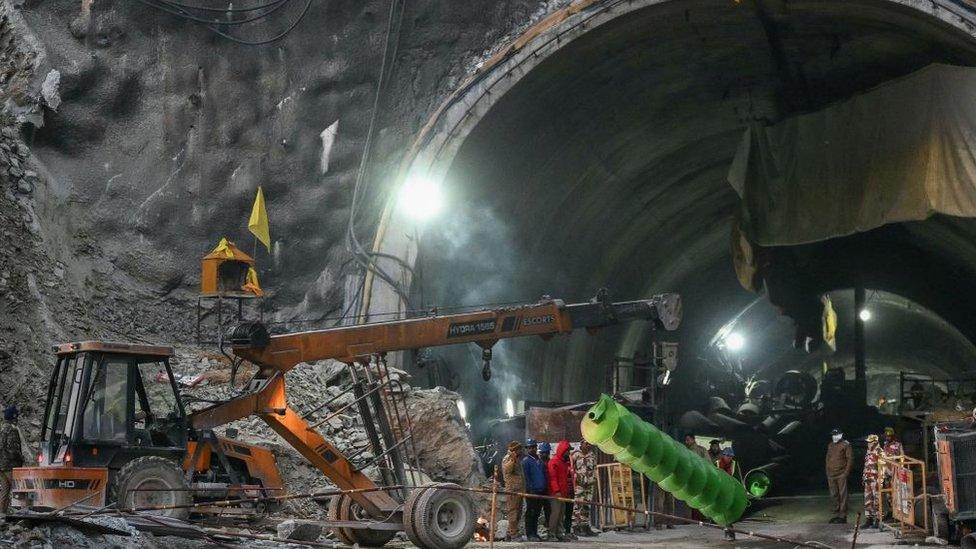Uttarakhand tunnel collapse: Machine repairs prolong ordeal for trapped Indians
- Published

The rescue operation has been delayed several times
Rescue work to save 41 workers trapped in a tunnel in India's Uttarakhand state has been delayed again because of a problem with the drilling machine.
The US-made machine is being used to drill through the debris to create an escape route for the workers.
Officials say the machine is being repaired and that drilling work is likely to restart on Friday.
The workers have been stuck inside the tunnel for 12 days after a portion of it collapsed due to a landslide.
A section of the 4.5km (3 miles) Silkyara tunnel in the Indian Himalayas caved in on 12 November.
Contact was established with the trapped men shortly thereafter, and they have been receiving oxygen, food, and water ever since.
Rescue officials had earlier announced that they would be able to extricate the men by Thursday morning. But the operations have been delayed after the latest technical glitch.
Bhaskar Khulbe, a former advisor to the prime minister's office actively involved in the rescue operations, told the media that the platform supporting the drilling machine had weakened, requiring an entire night of repairs throughout Thursday.
On Friday, a government release said, external that the platform of the machine had been reinforced using concrete and that the machine would be reassembled shortly.
The machine is drilling a hole into a 60m (197ft) debris wall that is preventing the workers from escaping the tunnel.
Authorities have been working to send multiple pipes of differing widths through the debris to create a micro-tunnel through which the workers can be brought out.
The plan is to wheel the workers out on stretchers through the pipes.
But the operation is a challenging one due to the presence of rocks, stones and metal inside the debris.
The operation was stalled on Wednesday too after workers encountered a thick metal rod which had to be cut using gas cutters.
Rescuers have drilled through about three-quarters of the debris so far, but it's unclear how long it will take for them to dig through the remaining part.
Rescuers are working on multiple plans to reach the workers
Speaking to reporters on Thursday, Lieutenant General Syed Ata Hasnain, a member of the National Disaster Response Force, said it was "difficult to put a timeline on such a complex operation".
"A lot of it depends on what the rescuers encounter while drilling through the debris," he said.
Arnold Dix, a tunnelling expert helping with the rescue work told reporters, that the machine had broken down thrice during the days-long rescue operations.
"We're the length of a bus away [from the trapped men]," he said. "We were hoping to see them this morning but it looks like the mountain has different ideas," he said.
The mountainous area is also prone to landslides and earthquakes, which is further hampering rescue efforts.
In the meantime, ambulances have been kept on standby outside the tunnel. Officials say the aim is to pull the workers out to safety and shift them to the nearby hospital as quickly as possible.
BBC News India is now on YouTube. Click here, external to subscribe and watch our documentaries, explainers and features.
Read more India stories from the BBC:
- Published20 November 2023
- Published17 November 2023